Unusual job on the bench today
Discussion
Update time again. Usually I put stuff up here that to me would seem more interesting than the everyday jobs that rot my mind and soul. But, as you've asked before to see the more mundane stuff I thought I'd put a couple of sizing explanations into the thread. It's actually a process that I have to explain regularly at work as Joe Public have this misconception that ring sizing involves a blanket process of squeezing and stretching their precious items. Others also believe it's some sort of black magic that gets their rings from size 'X' to size 'Y', which is odd! Anyway, this below is the way which a jeweller SHOULD size on a your rings (often not wedding rings..... I'll explain at the end).
So, first up is a cheapie 9ct yellow gold and diamond cluster. Customer requires it to be sized from H to size I 1/2.
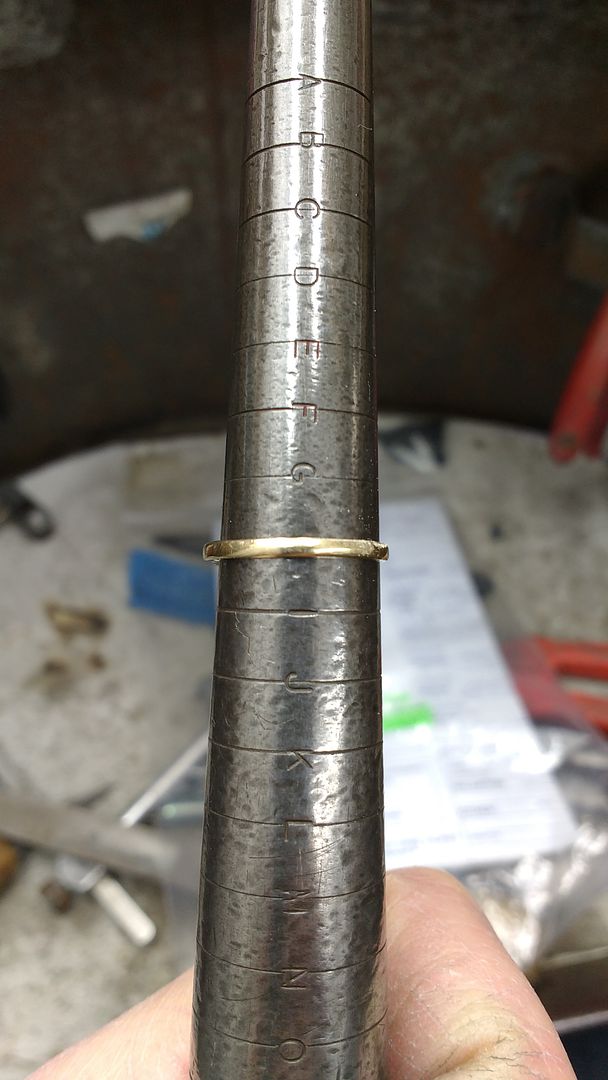
After checking the start size is correct the first thing to do is check for existing joints. Cutting through an existing joint (if only 1) removes the issue of creating a jigsaw puzzle later on. Multiple joints also leave the ring more vulnerable to cracking as the solder is usually more brittle than the core metal. In this case the ring is fine and we can cut where we like (so long as it's not through the hallmark). The ring is then cut, usually at the bottom, and pulled up the size stick to see how wide a gap we have to fill.
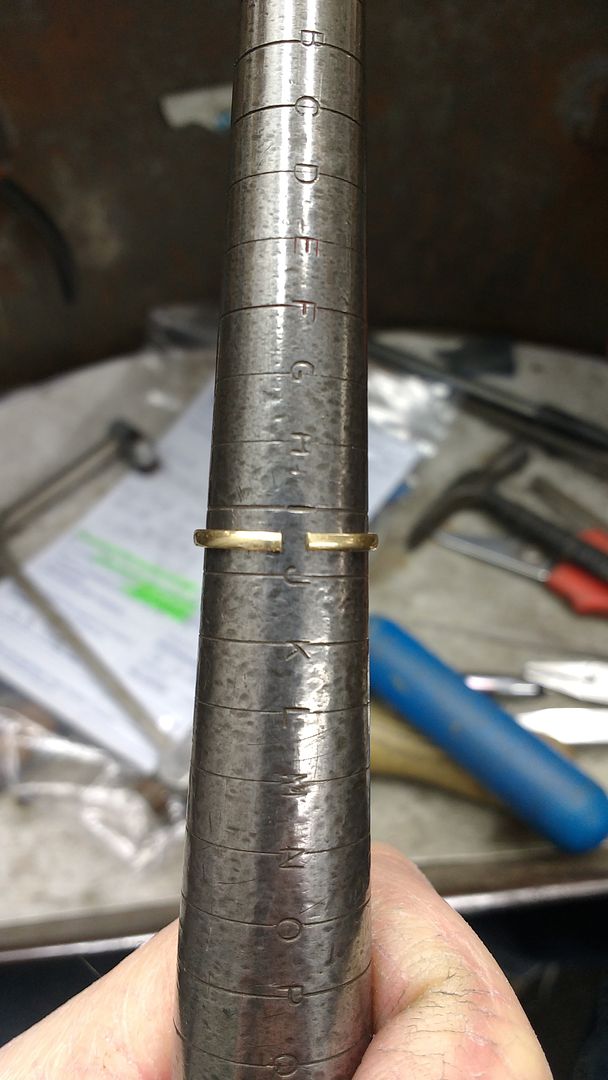
One size is usually approx 1mm but there's no set rule to it. I find that often I have to take more out when sizing down than when adding to make bigger, probably due to the metal having a little give in it. So, 1.5mm approx to fill. Here I've cut a chunk to the right size:
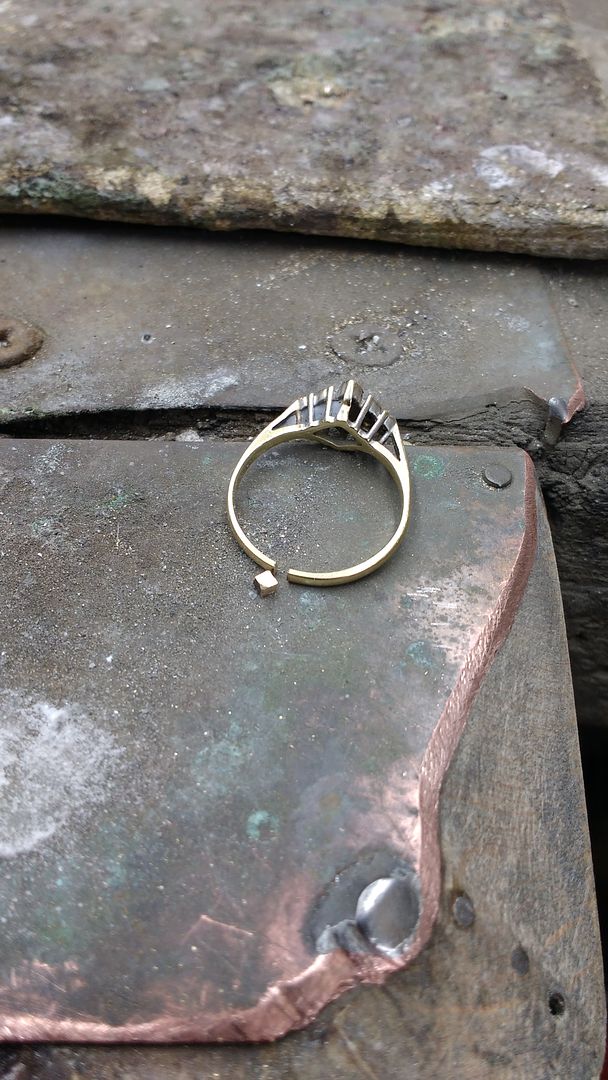
The peice is placed in the gap with the inner surface flush with the block to save too much filing. Borax is then put on the joints to aid the solder running.
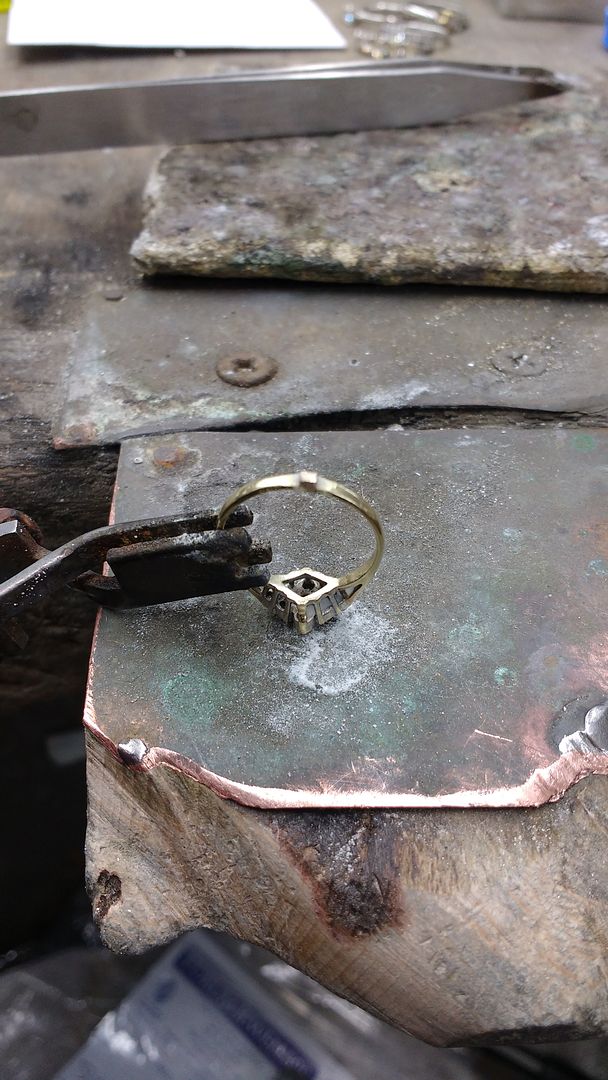
Solder applied and then heated until it runs into the joints. Different types of solder do different things. Some are hard, some are soft, some are in between. Solder also comes in different carats to match the core metal and to allow it to pass assay should it need re-hallmarking. Here I am using 9ct medium solder as the ring has no other joints nearby.

The solder melted and run:

And the inside surface. I usually reheat the inside to make 100% sure the solder has run through the joint. There's nothing more annoying than getting through the entire process to find a hairline crack in the joint and having to do it again.
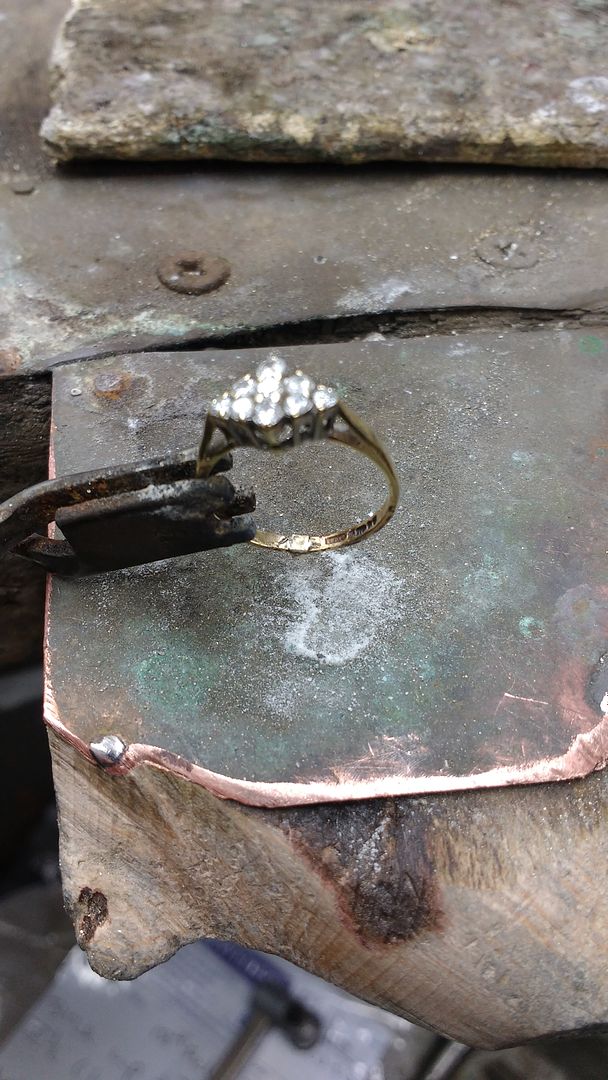
Any excess solder is then filed out from the inside, being careful not to take more metal than necessary. We take from the inside first so we can get an accurate measurement on the new size when it gets pushed up the size stick.

Mistakes happen and in this case I was a fraction out on the size. It's easy to tap it up a fraction if you make it a fraction too small but here you can see I went a little over. To solve it I just cut and resoldered one of the joints bringing it back to the right size.
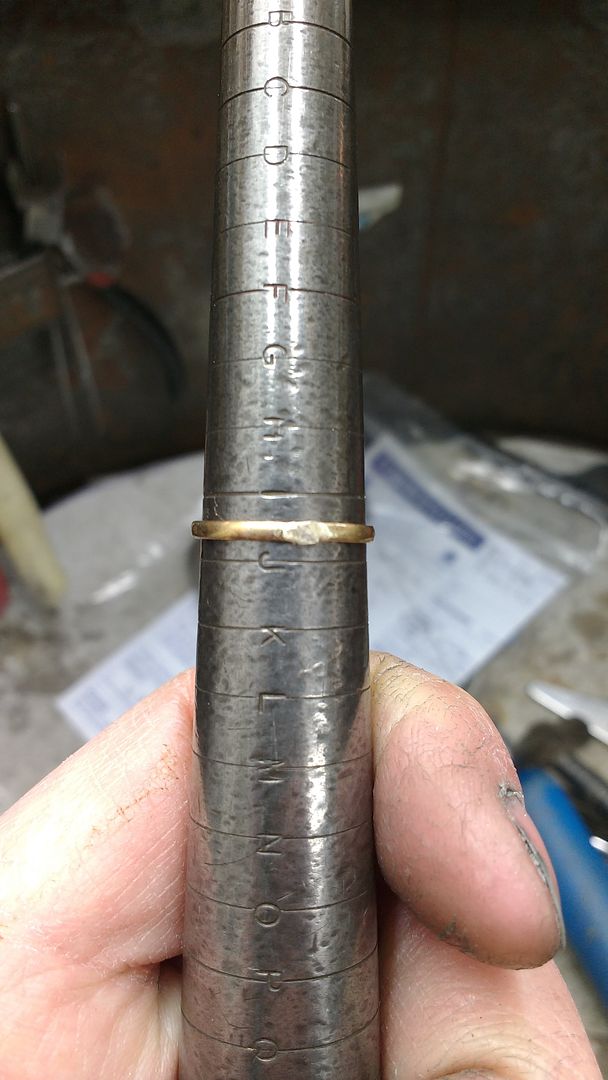
Once the right size has been achieved the sides etc are profiled to remove any excess solder. It's then buffed to bget ready for polishing:
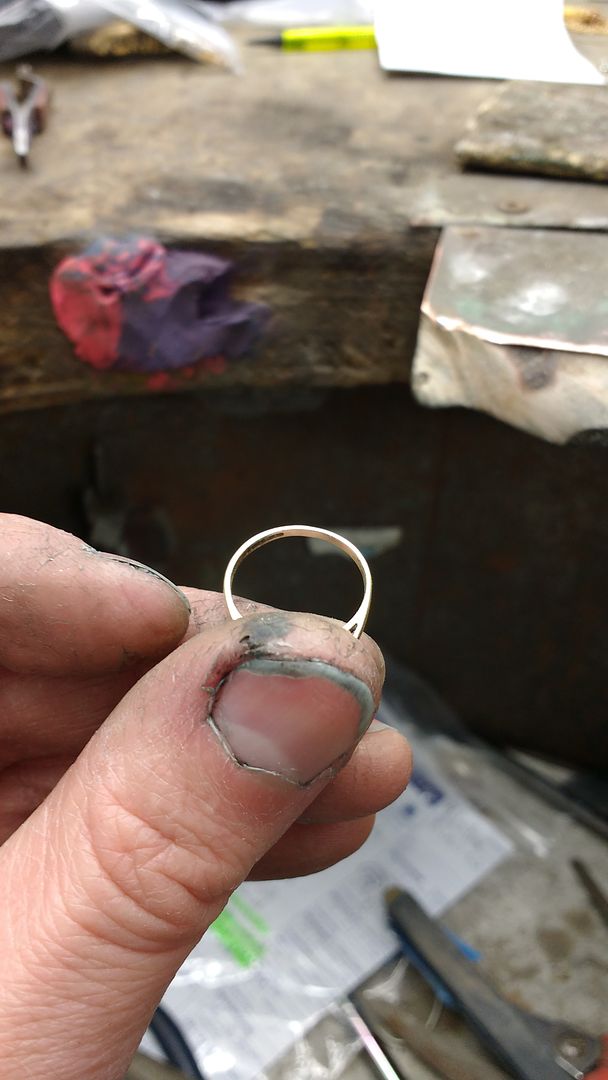
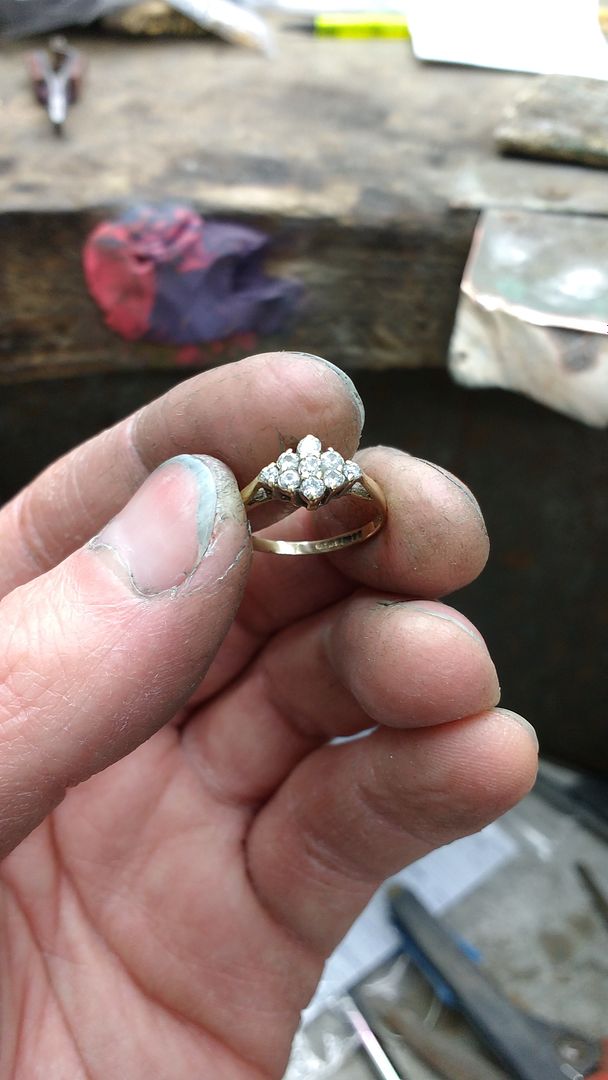
I'll polish that one in a little bit. Before that I'll demonstrate a ring being made smaller. In this case an 18ct white gold, diamond cluster. Start size is just short of a Q and it needs to go to a O.
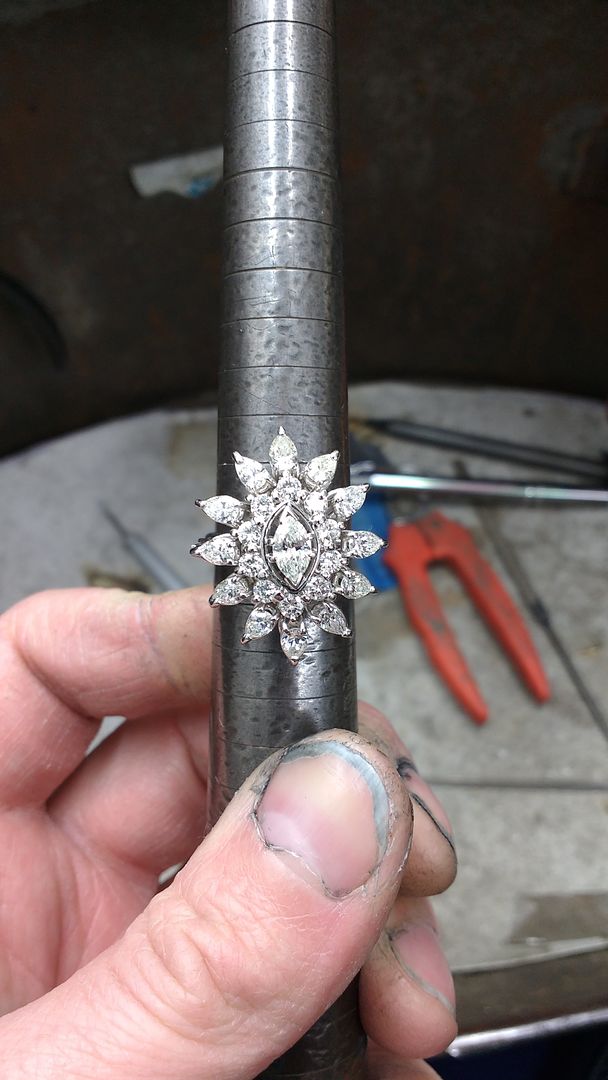

The ring has to come down just short of 2 sizes, so I cut out 2 mm of the metal from the centre of the ring. Again we check for existing joints. In this case there was a 2mm piece already in the ring so the best method is to remove it and rejoin.
The amount to be removed is marked with a saw:
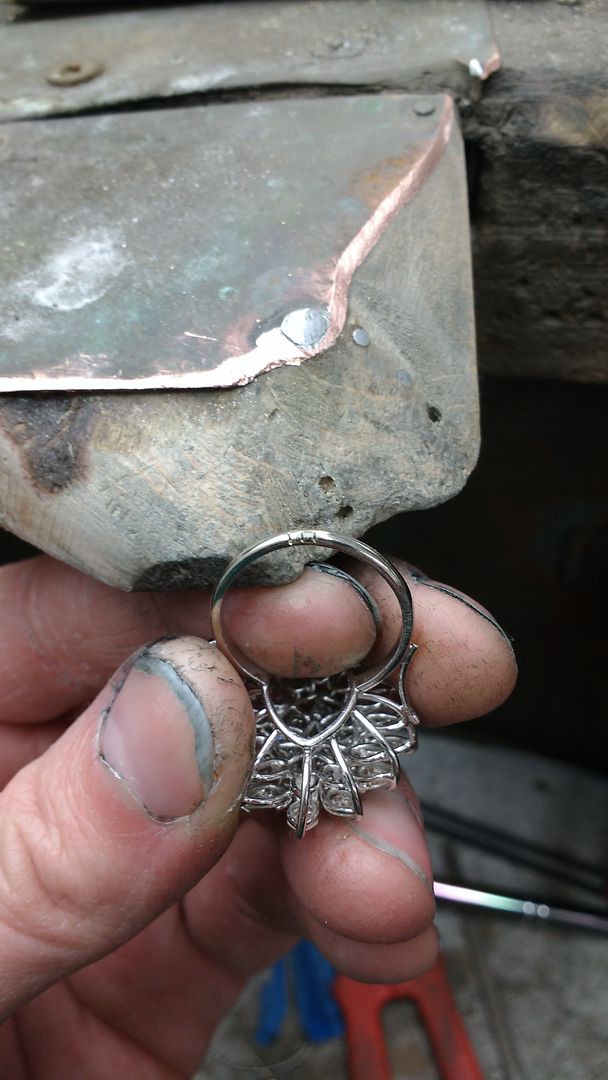
It's removed and the ends brought together and soldered. Bingo! Right size!
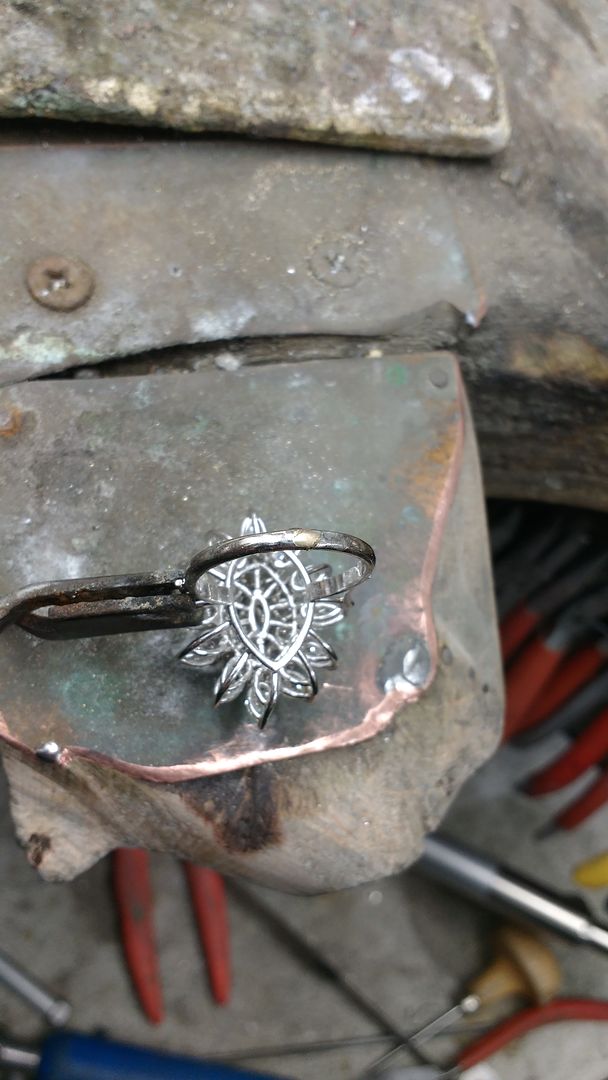
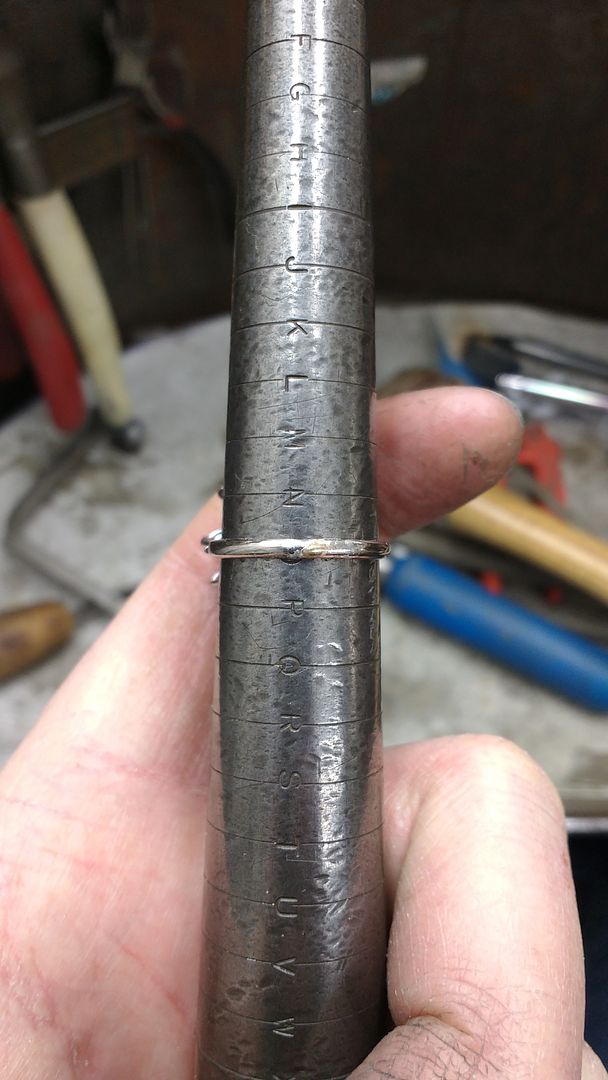
The ring is then profiled the same way as the previous ring and made ready for polishing:
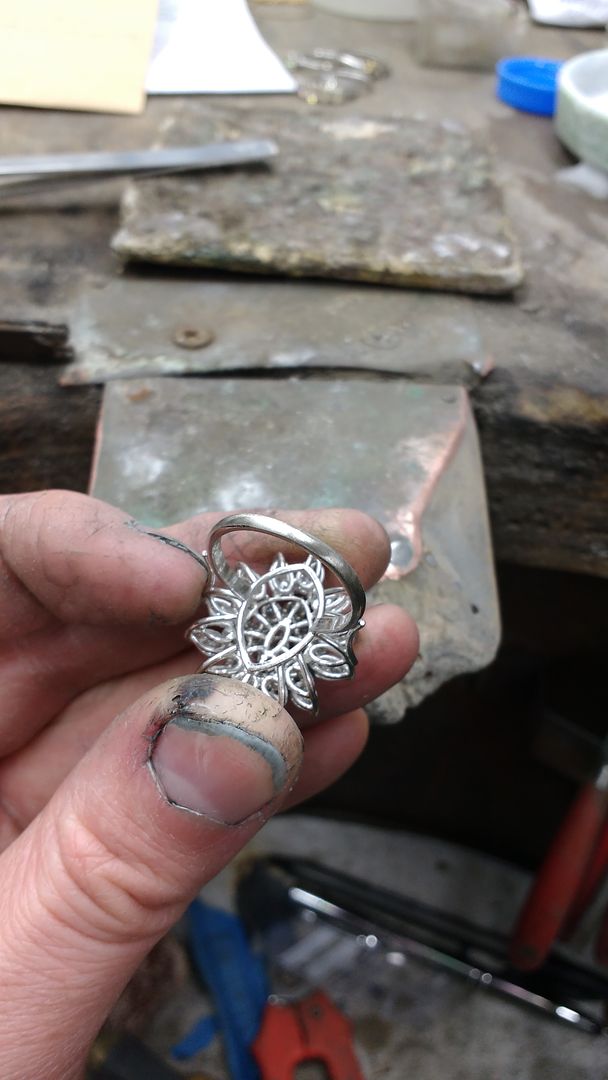
One thing that many customers ask me about is the trait of poor quality jewellers making their rings thinner when they size them. The reason this happens is because a bad jeweller will often file away more metal than is necessary or hammer the ring to stretch the metal. This is not going to happen if the job is done correctly. Obviously there is an element lost in the polishing but the amount is negligible if done correctly.
Wedding rings are a slightly different story when it comes to sizing. If we need to make a wedding band smaller we would usually attempt to compress the ring. This allows us to retain as much of the original metal as possible. Of course, with the use of diamonds and other metals in modern bands this isn't always possible, in which case we would cut a piece out and rejoin as per above. If a wedding ring needs to be made bigger (no more than a size or two) then sometimes we can stretch it to avoid the need for cutting. This process is very quick and easy but is not suitable for some metals, rings with stones, bands with multiple metals or existing joints. If this is the case we would add metal as above. If the band needs go up by more than 2 sizes we would usually add metal to avoid it becoming thin.
Anyway, the finished products: Polished and plated where needed.

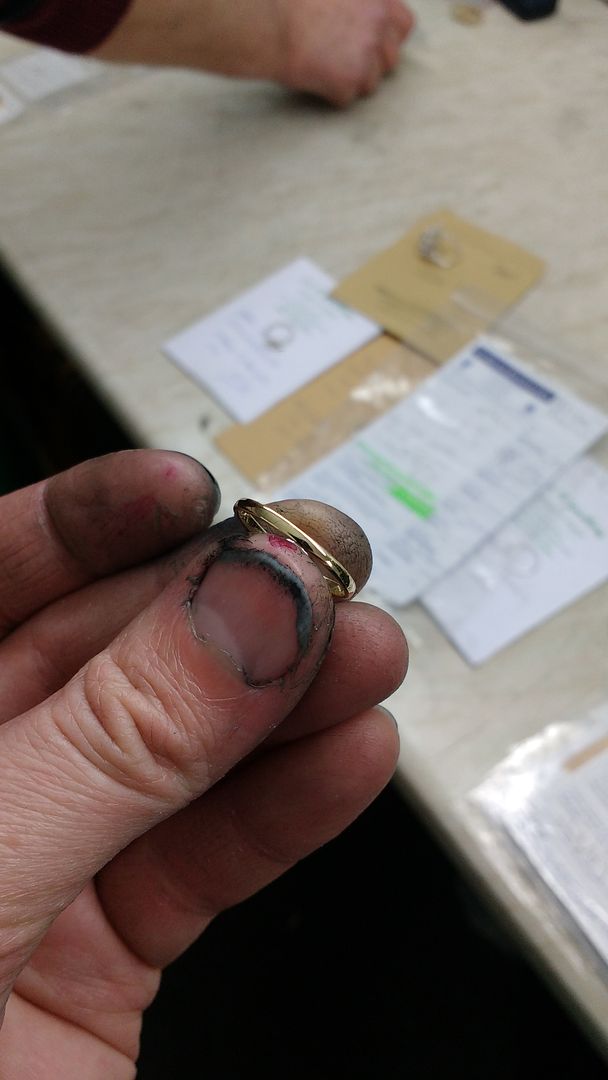
Eddie
So, first up is a cheapie 9ct yellow gold and diamond cluster. Customer requires it to be sized from H to size I 1/2.

After checking the start size is correct the first thing to do is check for existing joints. Cutting through an existing joint (if only 1) removes the issue of creating a jigsaw puzzle later on. Multiple joints also leave the ring more vulnerable to cracking as the solder is usually more brittle than the core metal. In this case the ring is fine and we can cut where we like (so long as it's not through the hallmark). The ring is then cut, usually at the bottom, and pulled up the size stick to see how wide a gap we have to fill.

One size is usually approx 1mm but there's no set rule to it. I find that often I have to take more out when sizing down than when adding to make bigger, probably due to the metal having a little give in it. So, 1.5mm approx to fill. Here I've cut a chunk to the right size:

The peice is placed in the gap with the inner surface flush with the block to save too much filing. Borax is then put on the joints to aid the solder running.

Solder applied and then heated until it runs into the joints. Different types of solder do different things. Some are hard, some are soft, some are in between. Solder also comes in different carats to match the core metal and to allow it to pass assay should it need re-hallmarking. Here I am using 9ct medium solder as the ring has no other joints nearby.

The solder melted and run:

And the inside surface. I usually reheat the inside to make 100% sure the solder has run through the joint. There's nothing more annoying than getting through the entire process to find a hairline crack in the joint and having to do it again.

Any excess solder is then filed out from the inside, being careful not to take more metal than necessary. We take from the inside first so we can get an accurate measurement on the new size when it gets pushed up the size stick.

Mistakes happen and in this case I was a fraction out on the size. It's easy to tap it up a fraction if you make it a fraction too small but here you can see I went a little over. To solve it I just cut and resoldered one of the joints bringing it back to the right size.

Once the right size has been achieved the sides etc are profiled to remove any excess solder. It's then buffed to bget ready for polishing:


I'll polish that one in a little bit. Before that I'll demonstrate a ring being made smaller. In this case an 18ct white gold, diamond cluster. Start size is just short of a Q and it needs to go to a O.


The ring has to come down just short of 2 sizes, so I cut out 2 mm of the metal from the centre of the ring. Again we check for existing joints. In this case there was a 2mm piece already in the ring so the best method is to remove it and rejoin.
The amount to be removed is marked with a saw:

It's removed and the ends brought together and soldered. Bingo! Right size!


The ring is then profiled the same way as the previous ring and made ready for polishing:

One thing that many customers ask me about is the trait of poor quality jewellers making their rings thinner when they size them. The reason this happens is because a bad jeweller will often file away more metal than is necessary or hammer the ring to stretch the metal. This is not going to happen if the job is done correctly. Obviously there is an element lost in the polishing but the amount is negligible if done correctly.
Wedding rings are a slightly different story when it comes to sizing. If we need to make a wedding band smaller we would usually attempt to compress the ring. This allows us to retain as much of the original metal as possible. Of course, with the use of diamonds and other metals in modern bands this isn't always possible, in which case we would cut a piece out and rejoin as per above. If a wedding ring needs to be made bigger (no more than a size or two) then sometimes we can stretch it to avoid the need for cutting. This process is very quick and easy but is not suitable for some metals, rings with stones, bands with multiple metals or existing joints. If this is the case we would add metal as above. If the band needs go up by more than 2 sizes we would usually add metal to avoid it becoming thin.
Anyway, the finished products: Polished and plated where needed.


Eddie
longshot said:
Very interesting as usual.
What's in the solder that you use other than gold for instance to make it solder?
What's the smallest and largest sized rings you have done?
Not 100% sure what is mixed in with the gold to make it solder but the metal and chemical content has to reduce the overall melting temperature in order for it to work. What's in the solder that you use other than gold for instance to make it solder?
What's the smallest and largest sized rings you have done?
I once made a 0.5ct diamond solitaire for a baby. That was size A! Stupid waste of money at that age.
Biggest is size Z+6. I've done a few of those for some sausage fingered folks.
Interesting pictures - great work!
On a related note, this video we made shows something similar - how a ring is resized using a laser.
Using a laser avoids the needs to re-join the ring with solder and can be beneficial, particular if re-sizing a ring made from platinum
https://www.youtube.com/watch?v=uaMUHHYzXBk
On a related note, this video we made shows something similar - how a ring is resized using a laser.
Using a laser avoids the needs to re-join the ring with solder and can be beneficial, particular if re-sizing a ring made from platinum
https://www.youtube.com/watch?v=uaMUHHYzXBk
ecain63 said:
Not 100% sure what is mixed in with the gold to make it solder but the metal and chemical content has to reduce the overall melting temperature in order for it to work.
I once made a 0.5ct diamond solitaire for a baby. That was size A! Stupid waste of money at that age.
Biggest is size Z+6. I've done a few of those for some sausage fingered folks.
My god, he must have been a giant!I once made a 0.5ct diamond solitaire for a baby. That was size A! Stupid waste of money at that age.
Biggest is size Z+6. I've done a few of those for some sausage fingered folks.
Thanks again for posting this. What is mundane to you is fascinating to us.
EddieSteadyGo said:
Interesting pictures - great work!
On a related note, this video we made shows something similar - how a ring is resized using a laser.
Using a laser avoids the needs to re-join the ring with solder and can be beneficial, particular if re-sizing a ring made from platinum
https://www.youtube.com/watch?v=uaMUHHYzXBk
Lasering is a new fandangled method and is very neat, i agree. Problem is it's only a surface joint and not as strong as a full thickness solder joint. It is however very handy for tacking claws in place in hard to reach spots where a traditional solder method would cause problems. In my opinion, as nice as the kit is, the old fashioned solder is far superior in terms of strength and durability. You can work around the harder stuff with good practice. I considered buying a laser machine but it's not worth it when I'm perfectly happy with old methods. Also, if we moved to laser machines i feel i'd be sacrificing the skills i'd been taught by my father in law. Stick with the basics and you won't go wrong.On a related note, this video we made shows something similar - how a ring is resized using a laser.
Using a laser avoids the needs to re-join the ring with solder and can be beneficial, particular if re-sizing a ring made from platinum
https://www.youtube.com/watch?v=uaMUHHYzXBk
Why would it be more beneficial with platinum than with other metals? I have no issue sizing platinum rings. If you use the harder solder you don't get dragging in the joint when polishing. You certainly don't if the joint is made perfectly flush. Just asking

EddieSteadyGo said:
ecain63 said:
Have things moved on then?
In all honesty, yes. The penetration of the laser depends its power, the quality of the setup, and the technique used to apply the power.
With modern laser equipment, you would only get a surface join if it isn't done properly.
If it works for you then great, keep it up. To be hobest, in hatton garden it'd make sense to use it as you're doing clean, simple work rather than repairs to old items. That's no dig at what you do, hatton garden is predominantly an engagement ring outlet and lasering makes sense if that's what you produce. I'll stick with the skills I have. Itll save me thousands of pounds on equipment I'd rarely use.
Feel free to add other interesting stuff here. This thread is open to everyone who works in the trade. Maybe Joe / Variomatic could put up a watch build??
Gassing Station | Watches | Top of Page | What's New | My Stuff




